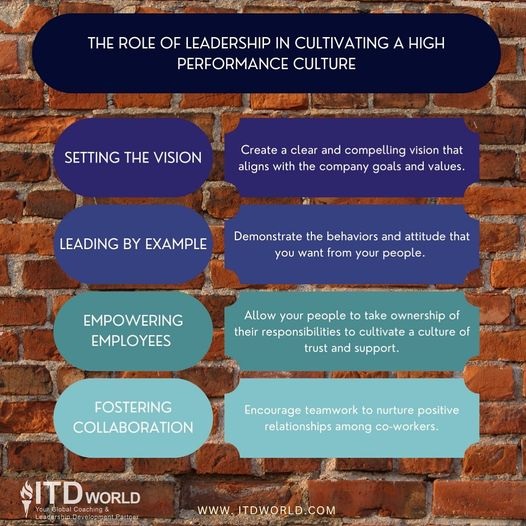Discover essential strategies and best practices to create a thriving, high-performance culture within your organization.
Organizations that consistently deliver exceptional results are better positioned to maintain an edge in today’s competitive business landscape. A high-performance culture is the cornerstone of such success. It is a shared mindset and set of behaviors that drive team members to excel, innovate, and achieve extraordinary results.
|
Author: Jonathan M. Pham |
Highlights
- A high-performance culture (HPC) is a culture where employees are highly engaged, motivated, and perform at their best. It fosters productivity, engagement, innovation, team cohesion, brand reputation, business growth, talent retention, a sense of belonging, and agility – thereby leading to significant organizational benefits.
- An HPC is characterized by people-focused elements like diversity, empathy, inspiration, learning, autonomy, and psychological safety, as well as performance-focused elements like accountability, clear guidelines, and shared leadership.
- McKinsey’s OHI, the Five Frames, and the 7-S Expanded Framework, along with other academic perspectives, emphasize the importance of alignment, leadership, communication, learning, and balancing competing values for cultivating such a culture.
- Tips for establishing an HPC include aligning strategy with culture, investing in talent, managing performance, promoting a people-centric environment, and leveraging technology.
- Effective leadership sets the vision, leads by example, empowers employees, and fosters collaboration to cultivate a high-performance culture.
- During the process of building an HPC, one may come across challenges like remote work, burnout, resistance to change, and short-term focus – which require solutions like hybrid work, wellbeing programs, a long-term perspective, and open communication.
What is a High-performance Culture?
A High-Performance Culture (HPC) is an organizational environment where team members are highly engaged, motivated, and consistently perform at their best (which translates to increased productivity, better customer satisfaction, and overall organizational success). Such a culture is often characterized by:
- Shared values and purpose: Employees are aligned with the company’s mission and values, leading to a strong sense of unity and purpose.
- Trust and collaboration: People trust each other and work together effectively.
- Continuous learning and development: Everyone is encouraged to learn and grow, leading to improved skills and knowledge.
- Innovation and creativity: Employees are empowered to think creatively and come up with new ideas.
- Recognition and rewards: Individuals are recognized for their contributions and rewarded for their achievements, boosting morale and motivation.
- Strong leadership: Leaders set a positive example and provide support/ guidance for others to succeed.
The Importance of Building a High-performance Culture in the Workplace
Cultivating a high-performance culture is a strategic investment that yields significant benefits – some of which include:
- Productivity and efficiency
Employees who feel valued and supported are more likely to be motivated and engaged, leading to increased output and improved quality. Additionally, a culture that emphasizes efficiency reduces errors and waste, resulting in cost savings for the organization.
- Engagement and morale
As team members are inspired to give their best, it translates to reduced absenteeism and turnover, creating a more stable and productive workforce.
- Innovation and creativity
A high-performance culture encourages innovation by valuing risk-taking and fostering open communication and collaboration. As such, those in such environments feel empowered to think outside the box and share their ideas, leading to faster adaptation to change and improved problem-solving (which is especially relevant in today’s business landscape given the recent digital transformation).
- Cohesive team dynamics
A shared purpose and values create a sense of belonging and unity, which leads to open and honest communication – thereby cultivating trust, respect, and collaboration among team members.
- Brand reputation and customer satisfaction
By fostering a positive and engaging work environment, companies empower people to deliver exceptional customer service. This, in turn, gives rise to increased customer loyalty and positive word-of-mouth, strengthening the organization’s brand image and reputation.
- Business growth and profitability
A strong culture aligned with strategy and leadership drives positive organizational outcomes such as increased revenue and reduced costs through improved productivity and efficiency. This ultimately leads to enhanced financial performance and sustainable growth.
- Talent management and retention
A positive and supportive work environment contributes to reducing employee turnover, saving time and money for the organization. Additionally, it also plays a role in acquiring top talent and supporting staff growth, leading to a more engaged and skilled workforce.
- Sense of belonging
A notable characteristic of a high-performance culture is its emphasis on connection. When employees feel a strong sense of community, stress, burnout, and absenteeism are less likely to surface.
- Business agility and resilience
As team members are encouraged to innovate and adapt, organizations become better equipped to pivot quickly in response to changing market dynamics. By embracing a mindset of continuous improvement and resilience, teams may navigate challenges and setbacks with greater efficiency, ultimately enhancing the company’s ability to thrive in an ever-evolving landscape.
Culture eats strategy for breakfast.
Peter Drucker

High-performance Culture Examples
Great company cultures don’t just happen – they’re meticulously crafted to empower employees and drive success. Here are some real-world examples that showcase the power of a high-performance culture in action:
- Netflix: Unleashing Innovation with Freedom and Responsibility
Imagine a workplace where you’re trusted to manage your own time, experiment with new ideas, and ultimately own the results. That’s the magic behind Netflix’s “Freedom and Responsibility” philosophy, which has contributed to a culture of high trust where people are empowered to make decisions and take calculated risks. The outcome? A breeding ground for innovation that has propelled Netflix to the forefront of the streaming industry.
- Google: Where Well-Being Fuels Creativity
Google isn’t just about work; it’s about fostering an environment where employees thrive. Their commitment to employee well-being shines through in their generous perks and flexible work arrangements. Not only do team members become happier, but they are also motivated to think outside the box and take risks that lead to groundbreaking products. After all, a well-rested and supported mind is more likely to come up with the next big idea!
- Pixar: The Power of Radical Candor and Collaboration
Pixar’s animation studios are legendary for their creative output. But what’s the secret sauce? They cultivate a culture of “radical candor,” where continuous feedback and open communication are paramount. This “psychological safety” allows employees to freely share ideas, critique each other’s work constructively, and ultimately produce films that resonate with audiences worldwide.
Under Satya Nadella’s leadership, Microsoft underwent a cultural transformation. They embraced a “growth mindset,” where challenges are seen as opportunities to learn and improve. This, coupled with a focus on diversity and inclusion, has unleashed a wave of innovation and employee engagement. It’s a testament to the power of a culture that values continuous learning and celebrates the contributions of all.
- Adobe: Investing in People, Igniting Performance
At Adobe, staff development isn’t an afterthought; it’s a core tenet of their high-performance culture. They offer a plethora of learning opportunities, encouraging people to continuously expand their skill sets. Additionally, by allowing individuals to take ownership of their projects, Adobe cultivates a sense of accountability and fuels a high-performance environment where everyone feels invested in collective success.
High-performance Culture Characteristics
Here are some key elements that distinguish a high-performance culture from an average one:
People-focused characteristics
- Diversity & Inclusion: A diverse workforce brings a variety of perspectives and experiences, leading to more innovative solutions. Inclusive practices ensure everyone feels valued and respected.
- Empathetic leadership: Leaders who understand and care about their team members facilitate a supportive and trusting environment.
- Inspire & influence: Strong leaders are capable of inspiring and motivating their teams to achieve great things.
- Continuous learning & development: A commitment to learning and growth enables team members to stay up-to-date and develop their skills.
- Opportunities for skill development: Offering opportunities for training and development empowers individuals to take on new challenges and advance in their careers.
- Autonomy: When people are given the chance to make decisions and take ownership of their work, they are likely to acquire a sense of responsibility and initiative.
- Growth mindset: A growth mindset drives individuals to embrace challenges and see setbacks as opportunities for learning.
- Supportive culture: A culture where collective success is emphasized and intertwined with personal achievements.
- Psychological safety: A safe environment where people feel comfortable sharing their thoughts and ideas without fear of judgment or criticism.
- Authentic leadership: Leaders who are honest and transparent build trust and credibility.
- Minimal politics: A culture free from office politics and favoritism ensures that everyone is treated fairly and equitably.
Performance-focused characteristics
- Little tolerance for low performers: A high-performance culture demands accountability and expects everyone to contribute their best.
- Clear performance guidelines & evaluation criteria: Well-defined performance expectations and evaluation criteria ensure that everyone is aligned and held responsible.
- Shared leadership: Distributed leadership empowers employees at all levels to be active, take on leadership roles, and contribute to the team’s success.
High-performance Culture Frameworks
Organizations striving for sustained success understand the critical role a high-performance culture plays. The models below offer valuable tools for cultivating a thriving work environment:
McKinsey’s OHI measures an organization’s health across 37 management practices and their impact on 9 key outcomes. This data-driven approach emphasizes crucial aspects like:
-
- Alignment: Are employee goals seamlessly integrated with the bigger picture of the organization’s strategy?
- Metrics that matter: Do the organization’s performance measures truly guide effective decision-making?
- Leadership that empowers: Does the leadership style foster a supportive and encouraging environment where team members feel empowered to contribute their best?
- The Five Frames of Performance and Health
This framework, outlined in McKinsey’s “Beyond Performance 2.0,” transcends mere performance metrics. It provides a comprehensive roadmap for leading large-scale change, encompassing five key areas:
-
- Aspiration (Health goals): Clearly defining the organization’s desired state of health across various aspects.
- Assessment (Mindset shifts): Identifying both positive and negative behavioral patterns and their underlying mindsets, paving the way for desired cultural changes.
- Architecture (Influence levers): Implementing strategies like role modeling, targeted communication, and reinforcement mechanisms to reshape the work environment.
- Action (Generation of energy): Fostering a culture of continuous improvement and innovation, where team members are actively engaged.
- Advancement (Leadership placement): Ensuring leadership at all levels embodies the desired cultural values and behaviors.
- 7-S Expanded Framework
Jack Weber’s expanded version of McKinsey’s classic 7-S model delves into the dynamic relationships between 7 key elements: strategy, structure, systems, style, staff, skills, and shared values. Each of them plays a crucial role, and their alignment is essential for effective performance.
Leaders may leverage this framework to understand how seemingly disparate aspects like leadership style (soft skills) and operational systems (hard skills) interact to influence the organization’s overall effectiveness.
- Other perspectives
Research from other academic sources reinforces the core themes identified in the frameworks above. Studies consistently highlight the importance of strong leadership, clear and transparent communication, and a focus on continuous learning for building a high-performance culture.
Additionally, models like the Competing Values Framework (CVF) offer insights into balancing seemingly conflicting organizational needs. For example, the CVF helps organizations find a healthy balance between control and flexibility, or between a focus on internal processes and a strong customer orientation.

What makes a high-performance culture
Read more: Leadership Values – 10 Qualities for Exceptional Results
How to Create a High-performance Culture in the Workplace
Building a high-performance culture requires a strategic and sustained effort. By following the best practices below, organizations may cultivate a thriving environment that drives innovation, productivity, and employee satisfaction:
-
Align strategy and culture
The process begins with a clear articulation of the desired culture – including the specific values, behaviors, and outcomes that the organization wants to embody (e.g. innovation, customer focus, teamwork, etc.). These values should be rooted in the organization’s mission and vision, reflecting its unique identity and aspirations.
Once the desired culture is defined, it’s essential to link it to the organization’s strategic objectives. For instance, a company that aims to become a market leader might consider promoting a culture of innovation and agility. By aligning culture with strategy, organizations create a cohesive environment where employees are motivated to contribute to the company’s success.
To ensure that such a vision is embraced by everyone, it’s crucial to openly share the organization’s values, mission, and strategic goals in a way that resonates with individuals on a personal level. Regular communication channels, such as company-wide meetings, newsletters, and intranet posts, can be used to reinforce the cultural message and keep people informed about the organization’s progress.
Example:
A technology company defines its desired culture as one that is innovative, collaborative, and customer-centric. To align this vision with its strategy of becoming a market leader, the company could implement initiatives such as:
- Hackathons: Encourage employees to develop innovative solutions to real-world problems.
- Cross-functional teams: Foster collaboration and knowledge sharing across different departments.
- Customer feedback programs: Prioritize customer satisfaction and leverage input to drive product improvements.
Read more: Agility Coaching – Navigating Change & Fueling Business Success
-
Invest in talent acquisition and development
A high-performance culture is built upon a foundation of talented and engaged people. Hence, organizations need to hire individuals who align with their culture. This means selecting candidates not only for their technical skills – but also for their values, behaviors, and potential to contribute positively to the team. For example, a company that prioritizes innovation and collaboration might prioritize candidates who are creative, open-minded, and enjoy working in a fast-paced environment.
Once employees are hired, it’s essential to invest in their ongoing development. This involves providing opportunities for training, mentorship, and coaching for them to grow their skills, knowledge, and career aspirations. Consider offering tuition reimbursement for those pursuing advanced degrees, and mentorship programs to connect new hires with experienced employees.
-
Pay attention to performance management and recognition
A fundamental principle of performance management is setting clear expectations. This involves defining specific targets and objectives for each employee (e.g. revenue generation, customer satisfaction, and market share for a sales rep), ensuring that they understand their role and responsibilities within the organization. Clear goals provide a framework for performance evaluation and help people stay focused on their priorities.
On the other hand, regular input (whether through formal performance reviews or informal check-ins) is essential for team members to be mindful of their performance and stay on track. Feedback should be provided in a timely and constructive manner, focusing on specific behaviors and providing actionable recommendations for improvement.
In addition, recognizing and rewarding achievements is a powerful way to boost morale. This can involve both formal rewards, such as bonuses or promotions, and informal recognition, such as public praise or special privileges. By acknowledging individual contributions, organizations establish a positive and supportive work environment where people feel valued and motivated to excel.
-
Foster a people-centric environment
One of the key components of a people-centric environment is prioritizing work-life balance. In other words, companies need to adopt policies and practices such as flexible work arrangements, paid time off, and wellness programs.
At the same time, it’s also crucial that they invest in team-building activities such as retreats to promote a sense of community and mutual respect. If there are team members who come from specific demographics (e.g. women, ethnic minorities), organizations should also organize employee resource groups (ERGs) to cater to them.
Another cornerstone of a people-centric environment is making them feel heard and valued. Specifically, companies need to actively listen to their feedback, address their concerns promptly, and take steps to improve the workplace. Regular surveys should be held to gather input on workplace culture, job satisfaction, and areas for improvement.
Read more: Cross-Cultural Communication – Guidelines for Leaders
-
Leverage technology
Technology has become an integral part of modern workplaces, and leveraging it effectively can significantly enhance performance and productivity. Performance management tools are great for tracking employee performance, exchanging feedback, and facilitating goal setting. They can streamline the performance review process, making it more efficient and effective.
On the other hand, a 360-degree assessment platform is valuable for gaining a comprehensive understanding of employee performance. By collecting feedback from peers, superiors, and subordinates, organizations may identify areas for improvement and come up with more targeted development opportunities.
Don’t forget about collaboration platforms, such as Slack or Teams, which were created to ensure seamless communication and collaboration among team members. These tools are amazing for facilitating real-time communication, file sharing, and project management, making it easier for teams to work together effectively.
The Role of Leadership in Cultivating a High-performance Culture
Leadership is a cornerstone of a high-performance culture. Effective leaders set the tone for the organization’s values, behaviors, and expectations, inspiring and motivating employees to achieve their best:

- Setting the vision: Leaders must articulate a clear and compelling vision for the organization that aligns with its goals and values. Their role is to promote a shared sense of purpose by emphasizing the company’s core values and how they contribute to the overall mission.
- Leading by example: Leaders must demonstrate the behaviors and attitudes they expect from their team members. This includes being ethical, accountable, and committed to continuous improvement.
- Empowering employees: Rather than micromanaging, leaders should learn to delegate tasks and responsibilities, allowing people to take ownership of their work. An environment of trust and support makes others feel valued and motivated to contribute their best.
- Fostering collaboration: Leaders should encourage teamwork by cultivating positive relationships among employees. Creating opportunities for team-building activities can help strengthen team cohesion and improve communication.
Read more: How Bad Leaders Undermine Success
Challenges & Risks of a High-performance Culture
While a high-performance culture offers numerous benefits, it also presents significant challenges and risks. Organizations must carefully navigate these obstacles to ensure that their strategies remain sustainable and positive.
- The rise of remote work: The increasing prevalence of remote work makes it difficult to foster a strong sense of community and collaboration.
- Loss of balance: The relentless pursuit of high performance, if not handled properly, may lead to burnout and a loss of balance in other areas of life (e.g. relationships, hobbies, personal pursuits, etc.). Not to mention, it may also result in a sense of assimilation, where individuals feel pressured to conform to a particular set of norms or values.
- Resistance to change: Employees may resist changes to the culture, particularly if they are perceived as disruptive or unfair.
- Short-term focus: An overemphasis on performance may lead to a short-term focus, neglecting long-term strategic goals.
Solutions:
- Hybrid work models: Organizations may consider implementing hybrid work models that combine the benefits of remote work with the advantages of in-person collaboration. Additionally, they should offer programs and policies that support work-life balance, such as flexible work arrangements and wellness benefits.
- Wellbeing programs: Providing employees with access to mental health resources and wellness programs may help mitigate the risks of burnout.
- Long-Term Perspective: Leaders should maintain a long-term perspective, balancing the pursuit of high performance with the need for sustainability.
- Open Communication: Encouraging open communication and feedback is crucial for identifying and addressing potential issues before they escalate.
Read more: Building High-performing Teams – Power Up Your People for Success
High-performance Culture Quotes
Check out more company culture quotes here!
Corporate culture matters. How management chooses to treat its people impacts everything for better or for worse.
Simon Sinek
High performing organizations have cultures of creativity and risk. They encourage workers to innovate and play.
Andy Hargreaves
Corporate culture is the only sustainable competitive advantage that is completely within the control of the entrepreneur. Develop a strong corporate culture first and foremost.
David Cummings
An organization’s ability to learn, and translate that learning into action rapidly, is the ultimate competitive advantage.
Jack Welch
An approachable and authentic CEO is essential to fostering a high-performance, open communications culture.
Scott Weiss
A culture of clear consistent communication and connection is the foundation of a high-performance team that thrives and flourishes.
Tony Dovale
Driving a positive, high-performing culture requires more than words. After all, everyone has a mission statement, but only the great organizations also have people who are on a mission.
Jon Gordon

High-performance Culture Training by ITD World
At ITD World, we believe that a high-performance culture is the cornerstone of organizational success. It’s more than just a buzzword; it’s a mindset that drives innovation, efficiency, and employee satisfaction.
We understand that every organization is unique, with its own specific challenges and goals. That’s why we offer a personalized approach to our training and coaching programs.
- One-on-one executive coaching: Our experienced coaches work closely with executives to develop their leadership skills, enhance their decision-making abilities, and foster a positive organizational culture.
- Team coaching: We facilitate team-building exercises and workshops that help teams work more effectively together, improve communication, and increase productivity.
- Customized training solutions: Our training programs are meticulously designed to address organizations’ specific needs, whether it’s leadership development, change management, or customer service.
Ready to transform your organization?
Contact ITD World today to learn more about our training programs and how we can support your organization’s success!
Other resources you might be interested in:
- Coaching Culture: Blueprint for Organizational Growth
- Talent Philosophy: Unlocking Workforce Potential
- Organizational Transformation: An Essential Guide
- Leadership Philosophy: How to Define Your True North & Follow It

